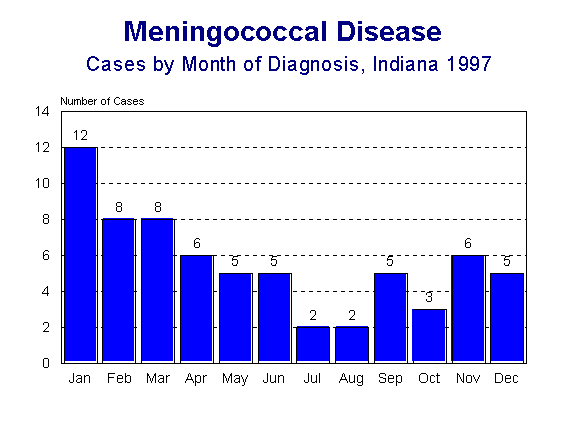
| Back to 1997 Indiana Report of Diseases |
Cases
= 67Crude rate
(per 100,000 population) = 0.96Age-adjusted race-specific rates
(per 100,000 population)Sex-specific rates
(per 100,000 population)Meningococcal disease is usually transmitted person to person via respiratory droplets from the nose and throat secretions of a person infected with Neisseria meningitidis. A probable diagnosis is defined as a positive antigen test in the cerebrospinal fluid (CSF) or clinical purpura fulminans in the absence of a positive culture. A confirmed case is defined as a clinically compatible case that is laboratory confirmed. All specimens must be obtained from a normally sterile site (e.g. CSF, blood, synovial fluid, pleural fluid or pericardial fluid). The rate of carriage of N.meningitidis in the nasopharynx in the general population is about 10 to 15%.
In 1997, there were 66 confirmed cases and one probable case of meningococcal disease reported. This is comparable to the 63 confirmed and two probable cases reported in 1996.
The incidence of meningococcal disease usually peaks in late winter to early spring. In 1997, disease occurred throughout the year with the lowest incidence in the summer and highest in the late winter (Figure 1).
Figure 1.

Meningococcal disease tends to strike babies, children and young adults. In 1997, the incidence according to age was as shown in Table 1:
Table 1. |
||||||||||||||||||||||
|
Although there is a meningococcal vaccine available in the United States, it is not effective against all Meningococcal serogroups, and is recommended for only certain groups of high-risk individuals including people who have terminal complement component deficiency, people with anatomic or functional asplenia, travelers to or U.S. citizens residents residing in countries in which N.meningitidis is hyperendemic or epidemic, or personnel who routinely are exposed to N.meningitidis in solutions that may be aerosolized. The specific serogroups that the vaccine is effective against are A, C, Y and W-135. Table 2 describes reported isolates in 1997.
Table 2. |
|||
Serogroup: |
1995 |
1996 |
1997 |
|---|---|---|---|
A |
--- |
1 (1.5%) |
-- |
B |
5 (9%) |
14 (21.5%) |
18 (26.9%) |
C |
11 (20%) |
8 (12%) |
11 (16.4%) |
Y |
9 (16%) |
18 (28%) |
10 (14.9%) |
W135 |
-- |
1 (1.5%) |
-- |
Z |
1 (2%) |
1 (1.5%) |
1 (1.5%) |
Ungroupable |
4 (7%) |
4 (6%) |
4 (6.0%) |
Unknown |
26 (46%) |
18 (28%) |
23 (34.3%) |
Total |
56 |
65 |
67 |
| Back to 1997 Indiana Report of Diseases |